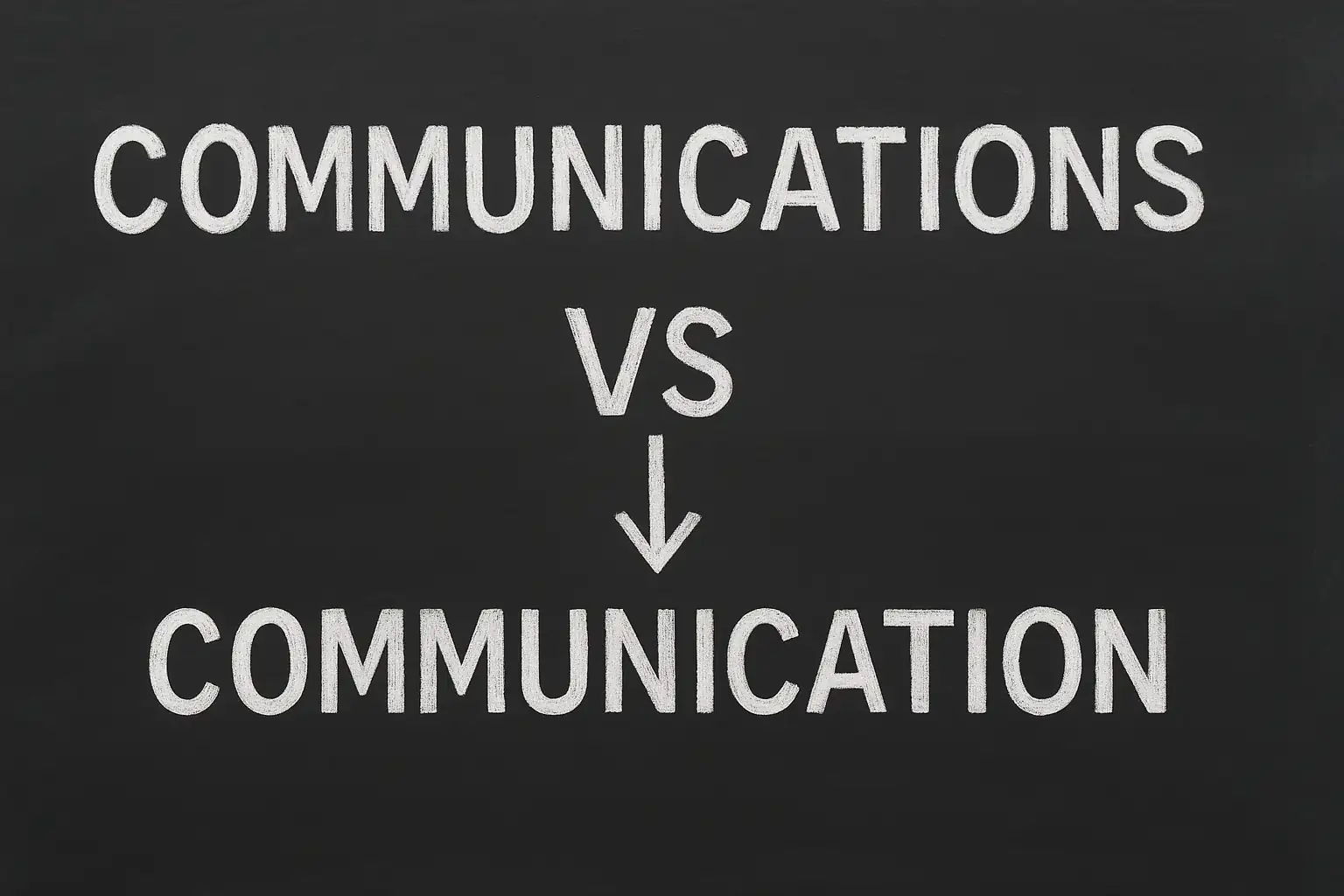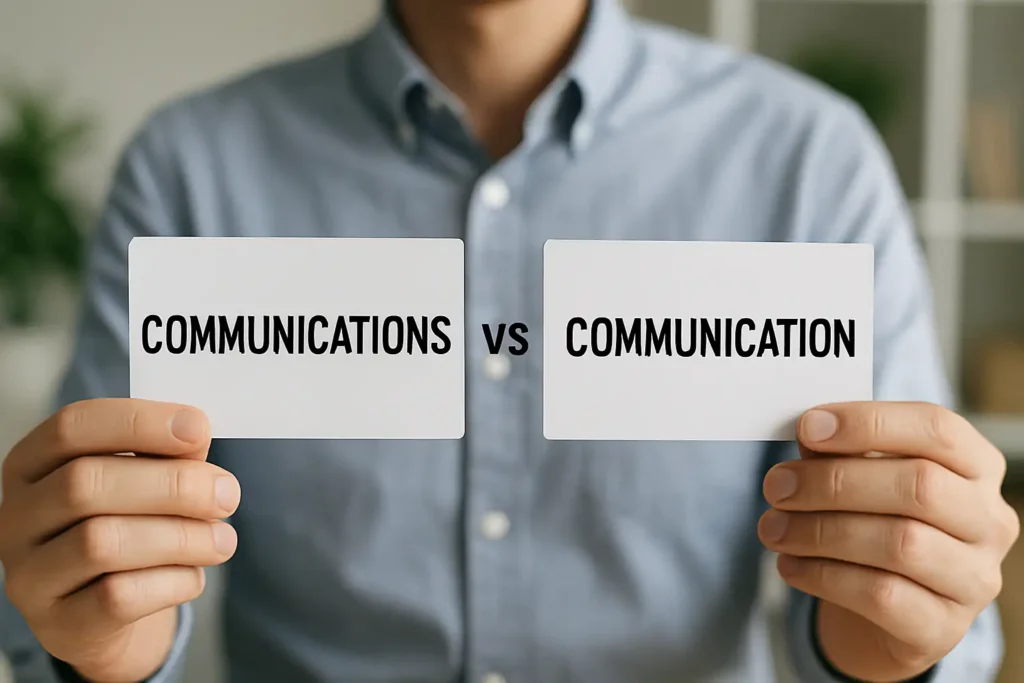
Amanda White
May 20, 2025
No Comments
How One Letter Can Change the Meaning in Business English
“Communications vs communication” might seem like a small distinction, but in business English, that one letter makes a big difference. Choosing the wrong term can confuse your audience, dilute your message, or even make your communication sound unprofessional.
In general, “communication” refers to the act or process of exchanging information, while “communications” often points to the systems, tools, or specific messages used in that process. Understanding this difference in terminology is vital when working across departments or with international teams.
For instance, in marketing, we might say, “Our communication with the client needs to be clearer,” referring to the overall process. But in IT, someone might say, “We upgraded our communications infrastructure,” referring to specific channels like email servers or VoIP systems. That’s a core example of how business English usage depends on context.
Understanding communication meaning helps reduce missteps in cross-functional meetings or emails. Next time you prepare a corporate presentation, ask: Am I describing a process (communication) or the tools and outputs (communications)?
If you’re managing teams, don’t miss the breakdown in Role and Responsibilities of Head of Corporate Communications, which explores how the right term influences leadership clarity.
Table of Contents
The Origins of “Communication” and “Communications” in Professional Use
Understanding the roots of “communications vs communication” helps clarify why the difference exists in today’s business world. “Communication” comes from the Latin communicare, meaning “to share.” It’s the abstract concept of sending, receiving, and interpreting messages.
“Communications,” on the other hand, evolved with technological advancement—telephone lines, radio broadcasts, and email systems. It refers to the tangible methods and tools of communication.
When you explore corporate communication terms, this subtle shift becomes more obvious. A company might invest in “communications technology” but focus on improving “employee communication.” It’s one of those areas where communication grammar guide rules intersect with real-world application.
The communication meaning in modern workplaces has also expanded to include emotional intelligence, clarity, tone, and intention. That’s why a well-developed business English usage strategy considers both forms for internal policies and branding.
Many global professionals benefit from personalized help, like Learn English with online English teacher, where learners get clarity on business language nuances. You can also explore broader workplace strategies in Corporate Communications Best Practices in 2025.
Common Corporate Situations That Require Each Term
Let’s bring the “communications vs communication” debate into the real workplace. Here are examples of which term fits better in various corporate scenarios.
📄 A company launching an internal newsletter would refer to it as part of its communications strategy.
📢 A manager training employees to give better feedback is improving communication skills.
📚 An HR guidebook may include a section on “effective employee communication.”
💳 A CTO might present a budget for “upgrading enterprise communications tools.”
The difference in terminology matters more than you might think. Using the wrong form in a presentation or formal email can make you seem less knowledgeable. Understanding business English usage like this becomes a professional asset.
In cross-cultural teams, the clarity between these two terms also reduces misunderstandings. A team in Germany might interpret “communications” strictly as technology, while a U.S. team thinks of it as media content.
Need support aligning your language with leadership goals? Check out English for Managers to Lead and Communicate Better.

Business Phrases That Use “Communication” vs “Communications”
Want to master the “communications vs communication” distinction? Start by using correct phrases in the workplace. Below are commonly used expressions that follow proper usage:
Phrases with “communication”:
✉ Communication breakdown
🏛 Communication strategy
🔊 Effective communication skills
Phrases with “communications”:
📢 Marketing communications
⚖ Corporate communications department
📈 Digital communications strategy
These business phrases align with the difference in terminology between abstract skills and concrete outputs.
The communication grammar guide is simple: use “communication” when referring to the act or quality, and “communications” for tools, outputs, or systems.
If you work in brand or reputation management, mastering these distinctions is crucial. For more insights, visit Why Corporate Image Is the Responsibility of Employees, and also review practical definitions from Business English.
Grammar Guidelines for Accurate Usage in Writing and Speech
Grammar can be tricky, but here are clear rules to help you use “communications vs communication” correctly in business writing:
✍ Use communication when it is uncountable: “Communication is key to success.”
📅 Use communications when talking about multiple forms or systems: “We improved our internal communications.”
🚫 Avoid saying “a communication” unless you’re referring to a formal document or message.
These grammar rules are part of every effective communication grammar guide. They matter when creating slide decks, emails, and policy manuals.
For example, a CEO might write in their annual letter, “Our communication with stakeholders is built on transparency.” Meanwhile, the IT manager might write, “Our communications network now supports real-time video calls.”
When in doubt, look at the function of the word in the sentence. That usually gives away the correct form.
For a deeper dive into how these forms are used professionally, see Is It Communication or Communications in Business English.
How Native Speakers Actually Use Both Terms in the Workplace
Even native speakers sometimes confuse “communications vs communication,” especially when switching contexts. But their real-life usage gives us helpful clues.
In day-to-day speech, native speakers use “communication” when referring to how people talk to each other: “Good communication between teams is vital.”
They use “communications” when referring to business units or infrastructure: “He’s the head of corporate communications.”
Understanding communication meaning this way ensures you’re using terminology that matches natural business English usage.
For example:
A British employee might say, “There was a lack of communication in the meeting.”
An American executive might say, “Our communications team is prepping the quarterly report.”
These nuances are helpful if you’re speaking in global meetings, writing reports, or managing international teams.
Practical Tips for Global Teams Choosing the Right Term
So how can global teams avoid confusion between “communications vs communication”? Here are some practical, real-world tips:
📓 Create a style guide that defines both terms with real examples.
✉ Review written policies and emails for proper term usage.
✅ Train your team with quizzes or short workshops on communication grammar guide basics.
When you’re managing employees from different cultural and language backgrounds, clear language becomes even more important. Corporate communication terms can vary by industry, but clarity always builds trust.
For companies like yours that operate internationally, knowing the difference saves time, reduces mistakes, and boosts professionalism.
Need help training your team or improving your company’s communication materials? Contact Us | CorporateEnglish.biz.
Latest Blog
More on Corporate Communication

Corporate Communications Job Description and
Corporate communications job description includes internal messaging, media handling, and strategic branding roles for



Why Corporate Communications Careers Are
Corporate communications careers are in high demand as companies seek better branding, messaging, and



Choosing the Best Corporate Communication
Corporate communication solutions include digital platforms and tools that streamline internal messages and improve







